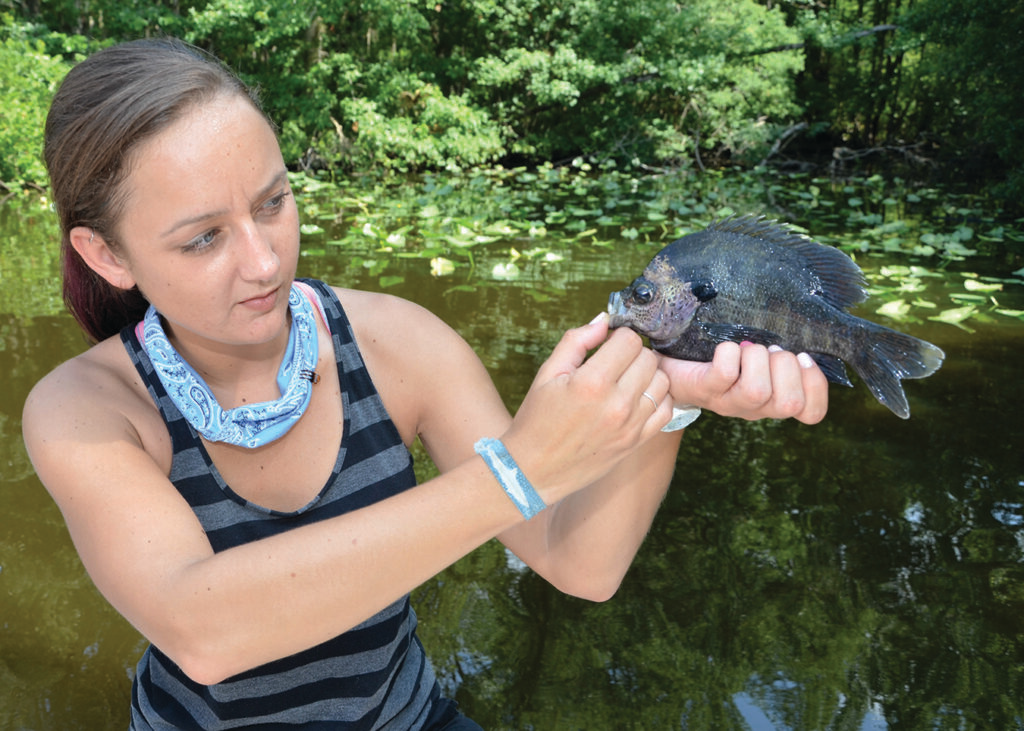As spring approaches and water begins to warm, fish prepare for their annual rituals that renew life and restock waterways. Each species spawns a little differently at varied times.
Everything depends upon water temperature. Not all waters warm at the same rate and not all fish even of the same species spawn at the same time in any given waterbody. On a massive and complex system like a major river watershed or a large impoundment like Lake Guntersville, the same species could spawn in one cove today and not in a nearby cove for weeks.
“Fish don’t all spawn at the same time,” says Phil Ekema, an Alabama Wildlife and Freshwater Fisheries Division biologist in Tanner. “Fish could spawn at different times in different parts of the same lake. That’s nature’s way to ensure the survival of the species. If they all spawned at the same time and something happened, they could have a failed year class that decimates the population.”
Rivers that carry water down from the north tend to run colder so the tributaries and shallow backwaters warm fastest. Therefore, fish might spawn in an oxbow lake weeks earlier than those in the main river channel. Depending upon water levels, temperatures and species, the “spawning season” could last for months.
Among freshwater fish, a more northern species accustomed to colder temperatures, smallmouth bass spawn around deeper rocky outcroppings, logs and other cover when water temperatures reach about reach 59 to 63 degrees. In the Tennessee River system, smallies usually spawn from late March through May.
Crappie spawn when water temperatures reach 60 to 65 degrees. Spawning begins in March but could extend into May. Crappie normally spawn in coves with gravel bottoms about two to four feet deep, possibly out to eight feet. On river systems, crappie might spawn on ledges in 14 to 15 feet of water.
Before moving shallow, crappie gather in deep staging areas near creek mouths and other channels. When water warms sufficiently, males move into shallow water to look for bedding spots.
Crappie don’t make traditional beds like many other fish. Instead, males collectively clear out a place near a stump, fallen tree or some other type of woody cover to protect themselves and their offspring from predators. Then, they wait for the females to arrive. Extremely prolific, each female crappie could produce between 5,000 and 40,000 eggs. Eggs hatch in about two or three days. Parents don’t defend the eggs or fry.

Photo by John N. Felsher
Largemouth bass begin spawning when water temperatures reach about 65 to 68 degrees. They like water two to four feet deep with sandy or gravel bottoms around weeds, flooded brush, fallen trees, docks or other cover. Male bass head shallow first. They use their lower jaws as pivot points and rotate themselves with their tails to scour out saucer-shaped nests. Females arrive about two to three weeks later.
Eggs hatch in eight to 10 days. Male bass guarding the nests eat very little, but they vigorously defend their eggs and young against a multitude of predators until fry reach about a half-inch long. Then, the male drives off the young bass by eating some. A male largemouth might spawn with multiple females over several months.
Like bass, bluegills and other bream species hollow out dish-shaped depressions in sandy or gravel bottoms in one to three feet of water. Bream frequently return to the same bedding grounds each year.
Redear sunfish, also called shellcrackers, spawn in the spring and the fall. In the spring, redears start spawning when water temperatures reach about 75 degrees. Bluegills follow when water temperatures hit about 80 degrees. A bluegill might spawn every 28 days as long as water temperatures stay comfortable. Spawning often lasts into the fall.
Catfish wait until late spring or summer for their annual reproductive ritual. Blue and channel cats begin spawning when water temperatures reach about 70 degrees, but spawning peaks when water warms to 80 to 84 degrees. These species begin spawning in May but could continue through August. Flathead catfish normally spawn in June or July.
All catfish species deposit eggs in nests, but they look for cavities rather than build their own beds. Cats might deposit their eggs in hollow hogs, crannies in rocks, under root masses, holes in undercut banks or even such things as buckets or tires on the bottom. When spawning, catfish seldom bite baits, but some people yank catfish from their cavities with their hands.
John N. Felsher is a professional freelance writer who lives in Semmes, Ala. He also hosts an outdoors tips show for WAVH FM Talk 106.5 radio station in Mobile, Ala. Contact him at [email protected] or through Facebook.




